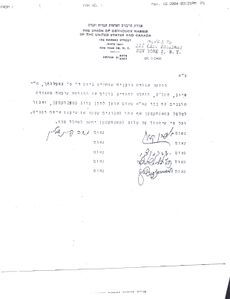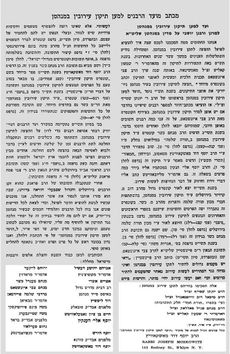عيروڤ
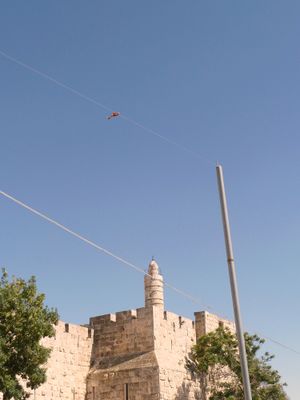
عيروڤ ([ʕeˈʁuv]؛ بالعبرية: עירוב؛ حرفياً 'اختلاط'؛ إنگليزية: eruv وتُكتب أيضاً eiruv أو erub؛ والجمع: عيروڤين eruvin [ʕeʁuˈvin]) هو a ritual halakhic enclosure that some Jewish communities, and especially Orthodox Jewish communities, construct in their neighborhoods to allow the activity of hotzaah mereshut lereshut (מלאכת הוצאה מרשות לרשות) which is prohibited on Shabbat: carrying objects from the private to the public domains and transporting objects four cubits (about two meters) in the public domain. An eruv accomplishes this by symbolically integrating a number of private and public properties into one larger "private domain" by surrounding it with mechitzas, thereby avoiding restrictions of transferring between domains. Often a group constructing an eruv obtains a lease to the required land from a local government.[1]
An eruv allows Jews to carry, among other things, house keys, tissues, medication, or babies with them, and to use strollers and canes. The presence or absence of an eruv thus especially affects the lives of strictly observant Jews with limited mobility and those responsible for taking care of babies and young children.
تعريف
حظر التنقل بين الأحواز
In Jewish tradition it is commonly said that "carrying" is forbidden on Shabbat. Specifically, "transferring between domains" (הוצאה מרשות לרשות) is considered one of the 39 categories of activity prohibited on Shabbat.
The halacha of Shabbat divides spaces into four categories:
- Private domain (reshut hayachid), such as a house
- Public domain (reshut harabim), such as a very busy road
- Carmelit, which includes most other places
- Neutral domain (makom patur), such as the flat space on top of a pole
A domain is defined as public or private based on its degree of enclosure, not its ownership.[2] The rules here are complex, and expertise is needed to apply them.
On Shabbat, it is forbidden to transfer an object from one domain to another, including from one person's house to another adjacent house. The only exception is transferring to or from a neutral domain (which is rarely relevant).
In addition, it is also forbidden to transfer an object for a distance of 4 cubits (approximately 2 metres) within a public domain or carmelit.
المصادر
In the Bible, Jeremiah 17:21–22 calls on Jews "not to bring any burden into the gates of this city", suggesting that carrying a "burden" within the city was permissible, even though the city consisted of numerous separate private domains. The commentary of Radak suggests that such carrying was permitted because Jerusalem had an eruv and its walls formed the boundary, so carrying within the city was permitted.[3] This view that an entire city could have an eruv influenced later views that an eruv could encompass a "courtyard" covering a wide area.
القوانين المحددة للعيروڤ
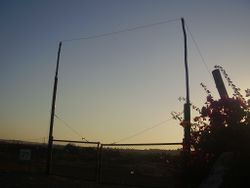
اختلافات بين الجماعات الأرثوذكسية
التكيف بدون عيروڤ
Many of those living in areas without an eruv are accustomed to life without one and have adapted their Shabbat practices accordingly. However, those who live in a place that has an eruv and are visiting a place without one, or if the eruv is temporarily out of service (perhaps due to wind or snow damage), may have difficulty making adjustments. Equally, those with young children, certain medical complaints and certain disabilities often feel trapped during Shabbat.
تجمعات ذات عيروڤين
In Israel, almost every Jewish community is enclosed by an eruv. Outside Israel, there are over 150 community eruvin, as well as thousands of private ones enclosing only a few homes, or linking a synagogue to one or more nearby homes. Most major cities in North America have at least one, often surrounding only the Orthodox Jewish neighborhoods rather than the entire city. Outside North America, there are eruvin in Antwerp; Amsterdam; Bury, Greater Manchester (Whitefield); Gibraltar; Johannesburg; London; Melbourne; Perth; Rio de Janeiro; Strasbourg;[4] Sydney; Venice and Vienna.[5]
جدالات
The installation of eruvin has been a matter of contention in many neighbourhoods around the world, with notable examples including the London Borough of Barnet; Outremont, Quebec; تنافلاي، نيوجرزي؛ Agoura Hills, California; Westhampton Beach, New York; and Bergen County, New Jersey.
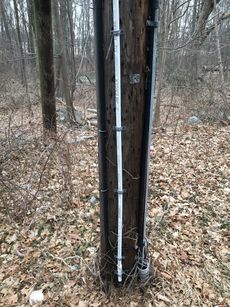
Between 2015 and 2018, there were ongoing issues with eruv markings extended on utility poles in a section of New Jersey. The adjoining municipalities of Mahwah, Upper Saddle River and Montvale, all border the state line[6] on the other side of which is Rockland County, New York, where there are large communities of Orthodox Jews. After some eruvin were extended into Bergen County, allowing travel in the area, the municipalities took action in 2017 to dismantle the lechi markings. The matter was taken to court, and in January 2018 the presiding judge in the lawsuits made it clear he felt the municipalities did not have a strong case, and urged them to settle. The three municipalities have settled with the eruv association, allowing the eruv borders to remain in New Jersey, reimbursed the association's legal fees, received agreement from the association to adjust the color of the lechi mounted on local utility poles, and agreed to work through a few remaining route details.
In general, state law has dealt with whether and to what extent government can permit or assist the erection and maintenance of boundary demarcations on public property. It has not dealt with the nature of the aggregation agreement or recognized an eruv as having legal effect or as implementing a meaningful change in real property ownership or tenancy. For purposes of accident liability, trespass, insurance, and other secular matters occurring on Shabbat, state law treats the properties within an eruv as continuing to be separate parcels.[بحاجة لمصدر]
أشكال أخرى للعيروڤ
The term eruv is also used to refer to other, unrelated concepts in halakha. These include the eruv techumin which enables one to travel beyond the normal travel restrictions on Shabbat or holidays, and the eruv tavshilin which enables one to cook for Shabbat on a holiday which immediately precedes that Shabbat.
Eruv techumin
المراجع
- ^ FeldmanNovember 24, Ari; Montage, 2017Forward. "What Is An Eruv?". The Forward.
{{cite web}}: CS1 maint: numeric names: authors list (link) - ^ "About Eruv". Chabad of West Monmouth County. Retrieved July 27, 2018.
Private and public do not refer to ownership. An enclosed area is considered a private domain, whereas an open area is considered public for the purposes of these laws.
- ^ Translation and Radak commentary from Rabbi A.J. Rosenberg. Mikraoth Gedoloth: Jeremiah Vol. 1. Judaica Press, 1985 (2005 printing) p. 152.
- ^ Katz, Nathan. Strasbourg : Le erouv de la capitale de l’Alsace. Actualité juive Hebdo, Oktober 17, 2013.
- ^ "Wiener Eruv: Status". Eruv.at. Retrieved August 21, 2016.
- ^ Yudelson, Larry (July 25, 2017). "Mahwah mayor wants to talk with eruv association". The Jewish Standard. Archived from the original on February 12, 2018. Retrieved February 11, 2018.
وصلات خارجية
عامة
- Eruv.org – Eruv Info, FAQ, and Global Eruv Directory
- BBC Eruv FAQ
- Eruvonline Blog
- Boston Eruv FAQ
- Introduction to the Modern Eruv – a detailed halachic overview by R' Hershel Schachter
- String Theory article, Harpers Magazine (paywalled)
- Barry Smith, The Ontology of the Eruv, from C. Kanzian (ed.), Cultures: Conflict – Analysis – Dialogue, Frankfurt: Ontos Verlag, 2007, 403–16. Video
- Adam Mintz, The History Of City Eruvin, 1894–1962
- Jennifer Cousineau (Spring–Summer 2005). "Rabbinic Urbanism in London: Rituals and the Material Culture of the Sabbath". Jewish Social Studies. 11 (3): 36–57. doi:10.1353/jss.2005.0021. Retrieved June 13, 2007.
مراجع نصية
- Tractate Eruvin: Mishnaic text with the commentary of Rabbi Pinchas Kehati
- Tractate Eiruvin
- CS1 maint: numeric names: authors list
- Short description is different from Wikidata
- Articles with hatnote templates targeting a nonexistent page
- Articles containing إنگليزية-language text
- Pages using Lang-xx templates
- Articles with unsourced statements from February 2015
- عيروڤين
- Jewish courts and civil law
- Laws of Shabbat
- يهودية أرثوذوكسية
- Shabbat innovations
